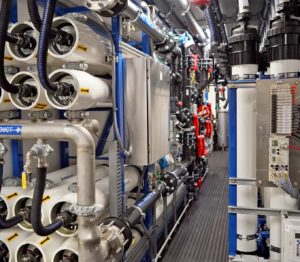Thorough investigation, application of specialized equipment key to selenium removal.
Problem
A former coal-fired power plant in the Northeastern U.S. had converted to a natural gas source. However, due to stringent EPA mandates, its remaining coal ash ponds, the byproduct of decades of burning coal, would need to be mitigated. That clean-up process is often compounded by the presence of selenium, a difficult-to-treat heavy metal frequently found in ash ponds.
The facility’s treatment process handles the selenium during warmer months, but requires enhanced treatment, including ultrafiltration and reverse osmosis during colder weather. With lower temperatures, selenium generally takes on selenate form, which complicates the typical chemical and physical processes used to remove it. Additionally, snow melt and rainwater lead to leachate from the coal ash waste, which requires selenium removal, pH adjustment and other modifications prior to discharge into a nearby water source.
The plant attempted to purchase and manage its own reverse osmosis (RO) equipment in order to maintain its ash pond during cold-weather months, which can last more than half the year. However, the contractor that the plant assigned to support the project did not provide reliable support and the system failed after less than one hour.
Plant management subsequently requested MPW review the situation and propose a solution.
Solution
MPW dedicated the time to understanding the pond wastewater and researching the best processing methods. The company’s applications engineers ran projections using various chemistries to determine the optimal running conditions for a changing pond water system, then developed a process solution and provided the trial equipment to prove their theories on-site.
MPW designed a system consisting of an ultrafiltration (UF) unit, an RO unit and a combined UF/RO unit (UR). The process maintains a steady flow of effluent to keep pond levels from exceeding fill limits. Efficiency of the system is adjusted to the changing conditions of the pond water quality, maximizing output.
MPW worked with the customer to improve its pretreatment process both chemically and mechanically. The pretreatment effluent feeds the specially designed UR trailer to remove all the solids prior to removing enough of the dissolved solids to meet the strict discharge requirements.
The system allows the customer to budget a set amount to meet these limits. MPW field service technicians operate the equipment and continually test chemistry and equipment variations to improve efficiency. The process also allows for redundancy to maintain operations under adverse conditions.
Results
The UR and process system ran the first four months of its deployment with no upset or need for RO cleaning. Processing issues developed only after the pond was filled with concentrated contaminants from another pond, but even under those adverse conditions, discharge quality was maintained (albeit at lower flow output).
Following the first year of UR deployment, MPW presented a concentrate-recovery system. This system is targeted at maintaining a secondary waste pond, eliminating the need for off-site trucking for deep-well injection and handling high-conductivity upsets of the primary coal ash waste pond.
MPW’s ability to properly define the problem in the waste-handling system and apply those learnings to an equipment solution such as the UR were key in the success of this project. This is a long-term project that will be ongoing throughout the life of the plant.
